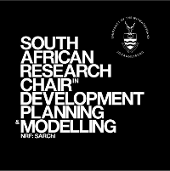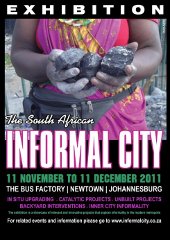You are here
UN-BUILT PROJECTS
Below is a brief excerpt from each of the projects in this category. Click on the links or image to see the full project panel details and illustrations.
Diepsloot – Housing & The Informal City
Exhibitor: 26’10 South Architects and Lone Poulsen
In this research inquiry, Diepsloot’s Reception Area has been used as a basis against which to ‘test’ existing formal housing typologies and to develop alternative strategies which respond to and learn from the dynamics of the Informal City. Diepsloot is a predominantly informal settlement located 40km north of Johannesburg’s city centre. As a post-apartheid township it acutely represents the challenges facing the South African state on matters of housing, service delivery and effective local governance. Based on detailed mappings of Reception Area produced by 26’10 south Architects, a master class involving various architects and housing specialists was held exploring the complex relationship between housing density, occupation density, built form and customisations such as rental rooms, small businesses and the delineation of communal and public spaces.
Diepsloot - Diep Soak & Curl
Exhibitor: 26’10 South Architects
This competition entry suggests an alternative approach to the provision of services in the upgrading of informal settlements. Whilst formal upgrading approaches concerned with defining ownership, security of tenure and eventually housing delivery are long and arduous processes, something can be done in the interim to improve inhabitants’ quality of life as well as stimulate the local economy through the provision of basic services. In fact, the failure of services that plagues informal settlements presents obvious opportunities for employment and development. Phase 2 of the Expanded Public Works Community Programme even makes provision for this.
Informal Studio - Ruimsig
Exhibitor: 26’10 South Architects in partnership with the Goethe-Institut SA, the University of Johannesburg and Prof. Lone Poulsen
The INFORMAL STUDIO: R U I M S I G has been carried out in partnership with the Goethe-Institut and the University of Johannesburg as an in-situ course on informal settlement upgrading. Sixteen masters students, together with residents of Ruimsig (an informal settlement on the western periphery of Johannesburg), have produced a detailed mapping and re-blocking study. The course was run partially from a studio within the settlement were students and teachers worked with local community architects in a process guided by NGOs and grass-roots organisations. This in-situ interaction formed a vital component linking theory and practice, ‘clients’ (residents), and service providers (students and teachers).
Sans Souci Cinema
Exhibitor: 26’10 South Architects, Lindsay Bremner
In the absence of a budget and local capacity to re-build the famous Sans Souci Cinema in Soweto, Johannesburg, the content rather than the container was realised. Through harnessing informal networks and local talent, the dramatic ruin of an old cinema formed the armature for a series of cultural events in one of Johannesburg’s poorest communities. The project set out to demonstrate that cultural production need not be limited to formal institutions and that relevant, rich and hybrid cultural identities and practices emerge from the perceived margins and interstices of the city.
Subsidised Housing Assets
Exhibitor: Finmark Trust
South Africa’s national housing subsidy programme, which was introduced with the advent of the first democratically elected government in 1994, has been lauded internationally as a highly significant and ultimately successful housing intervention. The programme provides qualifying beneficiaries (households who earn a monthly income of less than R3500 per month and satisfy other criteria) with freehold tenure over a 40m2 house on a 250m2 plot of serviced land. It is highly likely that the significant increase in the number of South African households living in formal dwellings between 1996 and 2007 – from 64.4% to over 70% - is primarily as a result of this national subsidy programme. The National Department of Human Settlements reports that between 1994 and 2009, a total of 2.94 million subsidy houses were either delivered or still under construction. Of these, 1.44 million (51%) have been formally registered in the Deeds Registry. These registered subsidy houses comprise just under one quarter (24%) of all registered residential properties in South Africa – clearly a significant proportion of South Africa’s property market.
Powered by AA Media and The Architects Collective of South Africa






